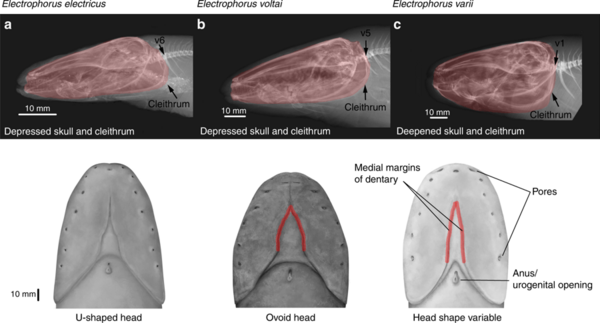Electrophorus electricus facts for kids
Quick facts for kids Electrophorus electricus |
|
|---|---|
 |
|
| Electric eel at the New England Aquarium, United States | |
| Conservation status | |
| Scientific classification | |
| Synonyms | |
|
Gymnotus electricus |
The electric eel (scientific name: Electrophorus electricus) is a famous electric fish from South America. Even though it's called an "eel," it's actually a type of knifefish. It lives in freshwater and can make powerful electric shocks!
Contents
What is an Electric Eel?
Not a True Eel
For a long time, people thought the electric eel was just one species. It was first described by Carl Linnaeus in 1766. He called it Gymnotus electricus. Later, in 1864, it got its own special group called Electrophorus.
In 2019, scientists discovered two more types of electric eels! They found these new species by looking at their DNA, where they live, and how strong their electric shocks are. So now, there are three known species of electric eels.
How Electric Eels Look
Electric eels have long, round bodies. They can grow to be about 2 meters (6.5 feet) long. They can also weigh up to 20 kilograms (44 pounds). This makes them the biggest of all the knifefish.
Their bodies are dark gray-brown on top. Their bellies are yellow or orange. Older female eels have a darker belly. Electric eels do not have scales. Their mouth is square and at the front of their snout.
A long fin runs along most of their body, all the way to their tail. They have a special air sac called a swim bladder. This helps them hear very well and float in the water.
Breathing Air
Electric eels need to breathe air. They have a special way of getting oxygen from the air. They must come to the surface about every ten minutes. They take a gulp of air before going back down. About 80% of the oxygen they use comes from the air.
How Electric Eels Make Electricity
Electric eels have three pairs of special organs in their belly. These organs make electricity. They are called the main organ, Hunter's organ, and Sachs' organ. These organs take up a lot of the eel's body.
These organs let the eel make two kinds of electric shocks. They can make low-voltage shocks and high-voltage shocks. The organs are made of tiny cells called electrocytes. These cells are lined up like batteries. Each cell adds to the electric power.
When an eel finds food, its brain sends a signal. This signal tells the electrocytes to open up. This makes a sudden change in electric power. It's like how a battery works!
Using Electricity
Electric eels use electricity in many ways. They use low-voltage shocks to feel what is around them. This helps them find their way in the water.
They use high-voltage shocks to find and stun their prey. Once the prey is stunned, the eel can easily grab it. They can even control their prey's muscles with electricity. This stops the prey from escaping.
The Sachs' organ helps the eel sense its surroundings. Each cell in this organ makes a small amount of electricity. All the cells together can make about 10 volts. The main organ and Hunter's organ make stronger shocks.
The electric eel's shock is strong enough to stun almost any animal. Eels can change how strong their shock is. They use weaker shocks for hunting. They use stronger shocks to stun prey or protect themselves. If they are bothered, they can keep shocking for over an hour without getting tired.
Even though it's the most famous, E. electricus actually has the weakest maximum voltage of the three species. It can make about 480 volts. The other species, E. varii and E. voltai, can make even stronger shocks!
Electric Eel Life

Where They Live
E. electricus lives in freshwater rivers and streams. You can find them in the Guiana Shield region of South America. Other types of electric eels live in the Amazon basin.
What They Eat
Young electric eels eat small creatures without backbones, like shrimp. Adult eels eat fish and even small mammals, like rats. Baby eels, called hatchlings, sometimes eat other eggs from their own nest!
How They Reproduce
Electric eels have a very interesting way of having babies. During the dry season, the male eel builds a nest. He uses his own saliva to make the nest. The female then lays her eggs in this nest.
A single nest can have as many as 3,000 baby eels hatch from the eggs. Male eels grow to be larger than females. They can be about 35 cm (14 inches) longer.
See also
 In Spanish: Anguila eléctrica para niños
In Spanish: Anguila eléctrica para niños




